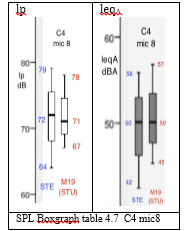C4v81 MW mic 8
| Stuart C4v81 M19(STU) MW mic8.wav |
Steinway C4v81 STE MW mic8.wav |
| Sound table 4.40 | |
The Stuart sound has a more percussive, louder onset. The SPL levels are very marginally different,1 dB apart. The leqA filtering is more indicative of the Stuart’s brighter, louder onset. The 2nd partial is more distinctive in the Stuart sound. After 1s , the Steinway sound is heard to rapidly diminish in volume, which influences the rounder tonal colour, whereas the Stuart volume level doesn’t diminished till 2.5s, establishing a brighter tone, of a wider harmonic spectrum, for a longer period than Steinway, before any change occurs in the tonal colour. The Stuart therefore, sounds a more sustained tonal balance, with less change, from the onset.
The spectrogram below shows the Stuart fundamental and 2nd partial frequencies are larger in amplitude than the Steinway. The higher amplitudes of the 2nd, & 4th partials in the Stuart sound would influence the brightness of


After a slower onset (i) , the Stuart sound transfers to its after-sound oscillation (ii) , .7s earlier than Steinway, establishing a more prominent sustain, earlier in the duration of the sound.

Soundboard:
The Stuart soundboard vibrated larger fundamental and 2nd partial frequencies, than the Steinway soundboard. The overall vibration of the soundboard across the harmonic spectrum for C4v81, was 67% greater in the Stuart soundboard.
The string scale of C4:
The diameter of the Paulello/Stuart wire is .25mm thicker, the tensile strength of the Paulello/Stuart wire is 177 N/mm² higher, the Paulello/Stuart is 1.5mm longer, and is set at 3.5kg higher tension. The yield or capacity of the Roslau/Steinway wire is 3.6% higher than Paulello/Stuart.




